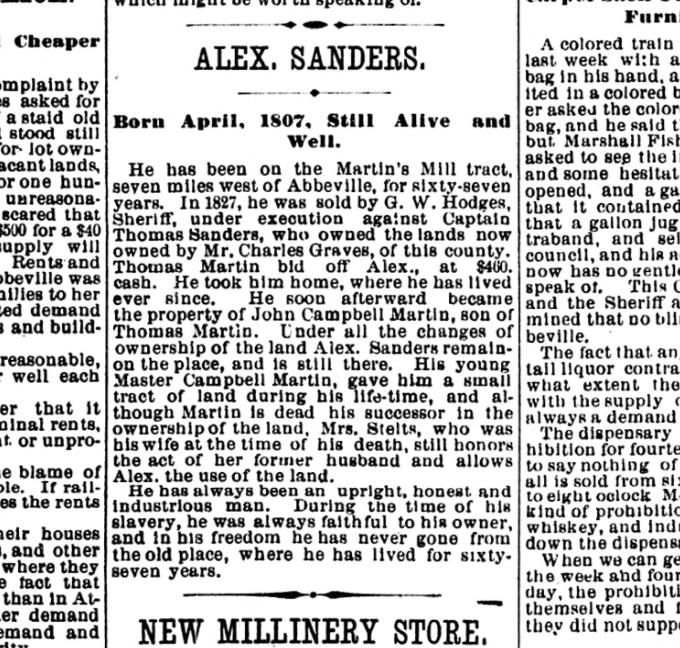Source: South Carolina Department of History & Archives
Series: S108093
Reel: 0003
Frame 00057
Item 002
Record 41
Date 2/15/1823
LAST WILL AND TESTAMENT
JOHN CAMPBELL deceased
In the name of God, Amen. I John Campbell of Abbeville district and state of South Carolina being of sound and disposing mind and memory and in a common state of health, calling to mind the uncertainty of life, and being desirous of disposing of all such worldly Estate as it hath pleased God to bless me with, do make and ordain this my last will and Testament in manner and form as Follows to Wit.
1st. It is my Will that the Whole of my Estate real and personal be sold on such credit or Credits as my Executors hereafter named may think most advantageous and most conducive to the Interest of my Legatus, my old Negro Lewis excepted, and also the land I own in Pendleton District that formerly belonged to Wm, McKee dec’d.
Item 2nd. To my grand daughter Arabella Chambers of the State of North Carolina I give and bequeath the sum of four thousand dollars to be paid her when she attains to twenty one years of age or Marries to her, her heirs and assigns for ever.
Item 3d. To my Grandson John S. Simmons I give and bequeath the sum of one thousand dallas, to be paid him when he attains twenty one years of age.
Item 4th. To Elizabeth Miller wife of George Miller of AbbevilleDistrict and State of South Carolina I give and bequeath the sum of four thousand dollars to her, her heirs and assigns for ever.
Item 5th. To my daughter Charlotte Cobb Wife of James Cobb, I give the sum of fifty dollars to her, her heirs for ever.
Item 6, The land I own in Pendleton consisting of two tracts containing about eleven hundred and twenty acres, formerly owned by Wm McKee, I give and bequeath the same to Jane McKee Widow Wife of the aforesaid Wm. McKee, dec’d, to her, her heirs and assigns for ever, pm the Condition that the said Jane shall well and truly pay to myself or to my Executors the sum of two hundred and fifty dollars if she does not comply with this condition, it is my Will that my executors sell one or both the tracts aforesaid, or so much thereof, at their discretion as will make the said sum of two hundred and fifty dollars, and give the balance to her the said Jane as aforesaid.
Item 7th. It is my Will that my Executors retain in their hands the sum of five hundred dollars for casualties and necessary expenses, until the business of the estate is done or completed.
Item 8th.All the balance of the Estate is, and it is my will that the same be divided into three equal parts and distributed as hereafter mentioned.
1st. To my Natural daughter Mary A. Simmons Wife of Thomas Simmons [or Semmons] of Abbeville District I give and bequeath one of those parts,to her, her heirs and assign forever.
2d. To my daughter Peggy Edwards Wife of Isam Edwards of North Carolina I give and bequeath one other of those parts to her, her heirs and assigns for ever.
3d. The other part (or third part) I give and bequeath to my daughter Arabella Martin and her son John C. Martin,to be equally divided between them Share and Share alike, John’s part to be paid to him when he attains twenty one years of age.
Item 9th. It is my Will that in selling of my Negroes that husband and Wife not be separated, and that my house woman Cloe have liberty in choosing her own Master, in my own family, and that old Lewis not be sold but retained in the care of my Executors and Will [well] used, and maintained out of my estate, in case he becomes unable to support himself.
Item 10. It is my Will that all my Just debts be paid, previous to a division of my estate into the three equal parts as mentioned in Item 8th. in case there be any such debts.
Item 11th. Isam Edwards of North Carolina owes me on a Note or obligation without seal a considerable sum of money, which if he refuses to pay or settle the same (with Interest at six per Cent) in part of the Legacy given his Wife, then in that case, I revoke the Legacy given to my daughter Peggy his wife, and give and bequeath the same to my other Legatees.
Lastly. I do hereby appoint my trusty and confidential friends Henry Johnson, Patrick Johnson and John Morrow Executors of this my last will and Testament, hereby revoking all former Wills by me made, ratifying and confirming this to be my last Will and Testament.
In Witness whereof I have hereunto set and seal this 21st day of April in the year of our Lord one thousand eight hundred and twenty one. Signed Sealed, Published & declared by the said Jno. [?] Campbell as his last will & testament, in our presence, who at the same time in his presence witnessed the same.
I Carris Goodwin
Samuel Huston J Campbell L. S.
A. Hunter
Proven by the caths of Samuel Huston & Harris Goodwin & Henry Johnson, Patrick Johnson & John Morrow qualified as Executors on the 15th day of February 1823. Before Moses Taggart, senr. O.A.D.
_____________________________________


